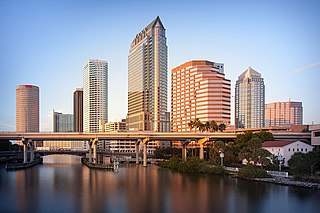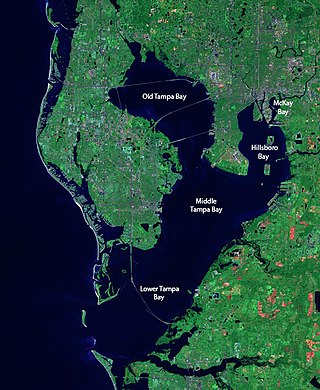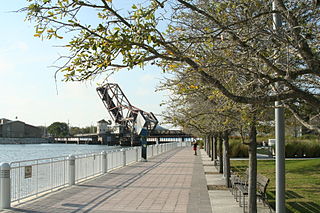
Tampa is a city on the Gulf Coast of the U.S. state of Florida. The city's borders include the north shore of Tampa Bay and the east shore of Old Tampa Bay. Tampa is the largest city in the Tampa Bay area and the county seat of Hillsborough County. With an estimated population of 403,364 in 2023, Tampa is the 49th-most populous city in the country and the third-most populous city in Florida after Jacksonville and Miami.

Tampa Bay is a large natural harbor and shallow estuary connected to the Gulf of Mexico on the west-central coast of Florida, comprising Hillsborough Bay, McKay Bay, Old Tampa Bay, Middle Tampa Bay, and Lower Tampa Bay. The largest freshwater inflow into the bay is the Hillsborough River, which flows into Hillsborough Bay in downtown Tampa. Many other smaller rivers and streams also flow into Tampa Bay, resulting in a large watershed area.

Ybor City is a historic neighborhood just northeast of downtown Tampa, Florida, United States. It was founded in the 1880s by Vicente Martinez-Ybor and other cigar manufacturers and populated by thousands of immigrants, mainly from Cuba, Spain, and Italy. For the next 50 years, workers in Ybor City's cigar factories rolled hundreds of millions of cigars annually.

Channel District is a residential neighborhood in the City of Tampa that includes an entertainment complex, just east of Downtown Tampa, Florida. It is bordered by Ybor Channel on the east and Garrison Channel on the south. Channelside is a nickname for the entertainment complex Channelside Bay Plaza, within the neighborhood that includes shops, restaurants, and bars. It is located next to the Florida Aquarium, American Victory Museum, Port Tampa Bay and a short stretch on the Tampa Riverwalk to the Tampa Bay History Center. Also located in the district is the Amalie Arena where the NHL's Tampa Bay Lightning play their home games. The Arena also hosts concerts and other events. The center of the Bay Plaza has a large open court for live music, with views of the downtown skyline, cruise ships and the Port of Tampa. It also houses a Sony Giant Screen theater. The TECO Streetcar has several stops in the district. Also, NEVs are being utilized by startups to link Tampa's core neighborhoods including Channelside. The Tampa Convention Center is located adjacent to the district to the west.

Not to be confused with Huntington Area Rapid Transit (HART) based in Huntington, New York.

The TECO Line Streetcar is a heritage streetcar transit line in Tampa, Florida, run by the Hillsborough Area Regional Transportation Authority (HART), owned by the city of Tampa, and managed by Tampa Historic Streetcar, Inc. It connects Downtown and Channelside to the historic Ybor City district. There is also an "In-Town" trolley-replica bus system that connects Downtown, Channelside, and Harbour Island.
The city of Tampa, Florida is officially divided into six geographical regions: New Tampa, West Tampa, Brooklyn Village, Downtown Tampa, Ybor City, and Channel District each coinciding with a respective Tampa City Council district. The neighborhoods are managed by Neighborhood and Community Relations, a department under Neighborhood Services, a city department which serves as a resource for residents and businesses.
Tampa Heights is one of the oldest neighborhoods within the city limits of Tampa, situated in the central part of the city. As of the 2000 census, the neighborhood had a population of 16,393.

Hyde Park is a historic neighborhood and district within the city limits of Tampa. It includes Bayshore Boulevard, Hyde Park Village and SoHo. Its ZIP code is 33606. Hyde Park includes many historic homes and bungalows. Its history and proximity to downtown Tampa make it a desirable residential neighborhood. Because of its convenient location, developments are being built in Hyde Park. Construction includes an expansion of Hyde Park Village, an upscale shopping and dining destination, as well as multifamily residential developments.
Port Tampa is a neighborhood in the southwestern most portion within the city limits of Tampa, Florida, on the western end of the Interbay Peninsula where the main port used to be. Within this neighborhood is Picnic Island Park as well as West Shore Elementary school.
Seminole Heights is a historic neighborhood and district located in central Tampa. It is bounded on the west by Florida Avenue, on the north by Hanna Avenue, on the east by Interstate 275 and on the south by Osborne Avenue. It includes many early 20th century bungalow homes and historic buildings. It was an early residential area of Tampa connected by streetcar. The area had an economic downturn in the late 20th century marked by increased crime, but has since seen a resurgence with new restaurants, brew pubs and independent businesses opening up. The neighborhood's historic homes, eclectic shops and gourmet restaurants are an increasing draw.
The modern history of Tampa, Florida, can be traced to the founding of Fort Brooke at the mouth of the Hillsborough River in today's downtown in 1824, soon after the United States had taken possession of Florida from Spain. The outpost brought a small population of civilians to the area, and the town of Tampa was first incorporated in 1855.

Downtown Tampa is the central business district of Tampa, Florida, United States, and the chief financial district of the Tampa Bay Area.

The Tampa City Council is the legislative body of the municipal government of the U.S. city of Tampa, in Hillsborough County, Florida. The City Council consists of seven members, each representing one of seven corresponding districts from which they were elected. City Council, as the city's legislative branch, is responsible for enacting ordinances and resolutions administered by the corresponding executive branch, the Mayor of Tampa.
Harbour Island is an island neighborhood within the city limits of Tampa, Florida and the sub-district within Downtown Tampa. The ZIP Code serving the area is 33602.
The following is an alphabetical list of articles related to the U.S. state of Florida.
Belmont Heights is a neighborhood within the district of East Tampa, which represents District 5 of the Tampa City Council. Demographically, The neighborhood did not report separately.

Old Seminole Heights is a neighborhood within the city limits of Tampa, in the U.S. state of Florida. The neighborhood is one of three which comprise the greater Seminole Heights district within the city. As of the 2010 census the neighborhood had a population of 14,729. The ZIP Codes serving the area are 33603, 33604, and 33610.

The Tampa Riverwalk is a 2.6-mile-long (4.2 km) open space and pedestrian trail along the Hillsborough River in Tampa, Florida. The Riverwalk extends along most of the downtown Tampa waterfront from the Channelside District on the eastern terminus to the mouth of the Hillsborough River and then north along the riverside to Tampa Heights, forming a continuous path that connects a multitude of parks, attractions, public spaces, and hotels. Among the notable points of interest along the Riverwalk are the Tampa Bay History Center, Amalie Arena, the Tampa Convention Center, Rivergate Tower, Curtis Hixon Waterfront Park, Water Works Park, and the Waterfront Arts District which includes the Tampa Museum of Art, Florida Museum of Photographic Arts, Glazer Children's Museum, and the Straz Center for the Performing Arts. Locations along the Riverwalk play host to many community events, most notably the numerous festivals held at Curtis Hixon Park and the arrival of the "pirate ship" Jose Gasparilla, which moors at the Riverwalk behind the Convention Center during the Gasparilla Pirate Festival.
Green ARTery is a greenway and trailway plan to connect neighborhoods in Tampa, Florida. The trails are bounded by the Hillsborough River to the North and West, McKay Bay and Old Tampa Bay to the South, and 40th Street to the East. Neighborhoods included in the ARTery include Old Seminole Heights, Southeast Seminole Heights, South Seminole Heights, Woodland Terrace, River Grove, Live Oaks Square, Lake Minihaha & Rogers Golf Course, Hampton Terrace, VM Ybor, East Tampa, Historic Ybor, Ybor Heights, East Ybor, Palmetto Beach, Downtown Tampa, Central Park, Tampa Heights, Ridgewood Park, Riverside Heights, and Channelside (Tampa).





















